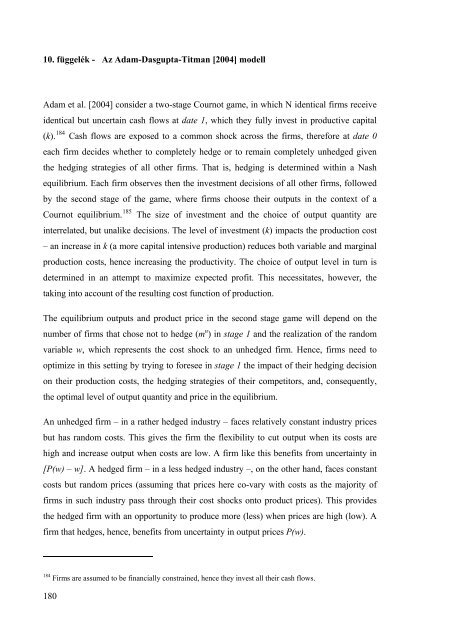értekezés - Budapesti Corvinus Egyetem
értekezés - Budapesti Corvinus Egyetem
értekezés - Budapesti Corvinus Egyetem
Create successful ePaper yourself
Turn your PDF publications into a flip-book with our unique Google optimized e-Paper software.
10. függelék - Az Adam-Dasgupta-Titman [2004] modell<br />
Adam et al. [2004] consider a two-stage Cournot game, in which N identical firms receive<br />
identical but uncertain cash flows at date 1, which they fully invest in productive capital<br />
(k). 184 Cash flows are exposed to a common shock across the firms, therefore at date 0<br />
each firm decides whether to completely hedge or to remain completely unhedged given<br />
the hedging strategies of all other firms. That is, hedging is determined within a Nash<br />
equilibrium. Each firm observes then the investment decisions of all other firms, followed<br />
by the second stage of the game, where firms choose their outputs in the context of a<br />
Cournot equilibrium. 185 The size of investment and the choice of output quantity are<br />
interrelated, but unalike decisions. The level of investment (k) impacts the production cost<br />
– an increase in k (a more capital intensive production) reduces both variable and marginal<br />
production costs, hence increasing the productivity. The choice of output level in turn is<br />
determined in an attempt to maximize expected profit. This necessitates, however, the<br />
taking into account of the resulting cost function of production.<br />
The equilibrium outputs and product price in the second stage game will depend on the<br />
number of firms that chose not to hedge (m u ) in stage 1 and the realization of the random<br />
variable w, which represents the cost shock to an unhedged firm. Hence, firms need to<br />
optimize in this setting by trying to foresee in stage 1 the impact of their hedging decision<br />
on their production costs, the hedging strategies of their competitors, and, consequently,<br />
the optimal level of output quantity and price in the equilibrium.<br />
An unhedged firm – in a rather hedged industry – faces relatively constant industry prices<br />
but has random costs. This gives the firm the flexibility to cut output when its costs are<br />
high and increase output when costs are low. A firm like this benefits from uncertainty in<br />
[P(w) – w]. A hedged firm – in a less hedged industry –, on the other hand, faces constant<br />
costs but random prices (assuming that prices here co-vary with costs as the majority of<br />
firms in such industry pass through their cost shocks onto product prices). This provides<br />
the hedged firm with an opportunity to produce more (less) when prices are high (low). A<br />
firm that hedges, hence, benefits from uncertainty in output prices P(w).<br />
184 Firms are assumed to be financially constrained, hence they invest all their cash flows.<br />
180
















